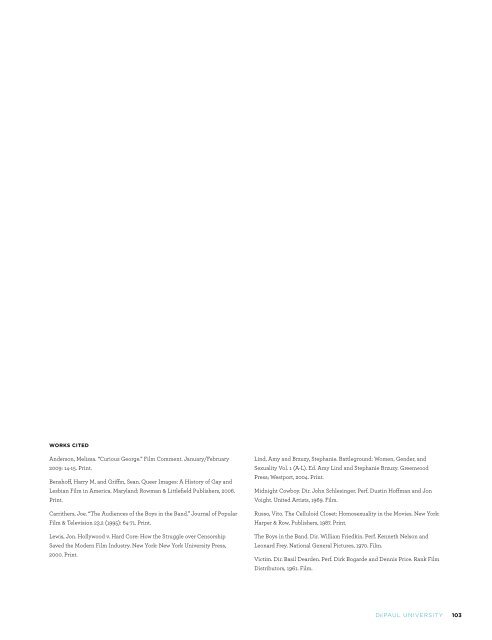UNDERGRADUATE
Ycb5305N2JX
Ycb5305N2JX
You also want an ePaper? Increase the reach of your titles
YUMPU automatically turns print PDFs into web optimized ePapers that Google loves.
THE POLITICS OF PROTECTION: DOMESTIC VIOLENCE<br />
ASYLUM SEEKERS DIVIDED ALONG GENDER AND RACIAL<br />
LINES<br />
Lizbeth Sanchez*<br />
Department of Latin American and Latino Studies<br />
There has been a surge of children and women seeking<br />
asylum from Central America in the past few years. This<br />
surge of immigrants seeking refuge has created a crisis for<br />
the U.S. in terms of how to deal with the situation. Gang<br />
violence in El Salvador, Guatemala, and Honduras has<br />
forced thousands of people to migrate north for survival.<br />
According to the United Nations High Commissioner for<br />
Refugees’ report (UNHCR), in 2014, “tens of thousands<br />
sought asylum in the United States, and the number<br />
of women crossing the U.S. border was nearly three<br />
times higher than in 2013” (UNCHR 2016, 2). The report<br />
indicates that “Women are under particular threat, being<br />
raped, beaten, extorted, abducted and murdered almost<br />
every day. El Salvador and Guatemala now have the first<br />
and third highest female homicide rate on the planet”<br />
(UNCHR 2016, 2). These findings demonstrate that<br />
women, in particular, are extremely vulnerable to violence<br />
in their home countries, which explains the high numbers<br />
of female Central American immigrants.<br />
The particular violence experienced by women not only<br />
comes from organized crime, but also from abusive<br />
partners in their homes. The UNHCR report states that<br />
“many women [whom they interviewed] cited domestic<br />
violence as a reason for flight, fearing severe harm or<br />
death if they stayed” (UNCHR 2016, 25). Because domestic<br />
violence targets a specific gender, women, domestic<br />
violence is considered a form of gender-based violence. In<br />
this sense I ask when women flee Central America from<br />
* This paper was prepared for LST 390, capstone in Latin American and<br />
Latino Studies, taught by Professor Carolina Sternberg.<br />
domestic violence, to what extent has the United States’<br />
refugee laws protected refugees seeking asylum from<br />
this specific kind of gender-based violence? I argue that<br />
the U.S.’s refugee laws have done very little to protect<br />
domestic-violence asylum seekers, especially those that<br />
have been coming from Central America. I establish<br />
that the U.S.’s asylum process is gendered, racialized,<br />
and politicized when working with domestic violencebased<br />
asylum claims. The U.S.’s refugee law creates an<br />
exclusionary form of “worthy” asylum seekers in order<br />
to expand its hegemonic power and identity as “hero” of<br />
the “most vulnerable” around the world, all while strictly<br />
restricting the entry of non-citizens.<br />
This research is important because there has not been<br />
enough scholarship on the ways in which current U.S.<br />
refugee law has impacted domestic violence asylum<br />
seekers, especially those who have been coming from<br />
Central America. With the surge of Central American<br />
immigrant women and children to the U.S. due to violence<br />
and poverty in their home countries, it is vital to explore<br />
the ways in which this population is treated in the U.S.’s<br />
immigration system. Not enough research on this subject<br />
has been produced through a feminist perspective that<br />
explores why, for the U.S., certain “victims” are more<br />
“worthy” of protection than others. It is important to<br />
understand how gender can bring a different approach in<br />
understanding the exclusions and identity formation of a<br />
“worthy victim,” particularly when looking at refugee law’s<br />
relationship to gender-based violence claims. It is also<br />
important to analyze to what extent these laws are doing<br />
what they were set out to do in theory.<br />
104 CREATING KNOWLEDGE


